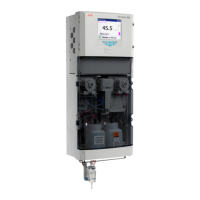
Do you have a question about the ABB Navigator 600 Silica and is the answer not in the manual?
| Power Supply | 100 to 240 V AC, 50/60 Hz |
|---|---|
| Power Consumption | 50 VA |
| Sample Temperature | 5 to 50 °C (41 to 122 °F) |
| Ambient Humidity | 0 to 95% RH (non-condensing) |
| Outputs | RS-485 Modbus |
| Enclosure Rating | IP65 |
Access and set common analyzer parameters.
Configure measurement settings like units and temperature.
Set up alarm conditions and relay outputs.
Configure analog output signals for measurements.
Set up data recording parameters and sample rates.
Configure network settings for Ethernet and email.
Access different logging and diagnostic levels.
Guidelines for safe operation and handling of the analyzer.
Compliance with electrical safety requirements and standards.
Explanation of warning and informational symbols used in the manual.
Precautions for handling chemical reagents and avoiding hazards.
General advice for safe operation before starting.
Definitions of warning, caution, and note symbols.
Diagram and list of main parts of the analyzer.
Detailed explanation of the chemical reactions for silica measurement.
Description of the sample and reagent fluid path.
Automatic shutdown sequence when sample is lost.
List of included and optional accessories.
Conditions for sample intake for accurate measurement.
Optimal site selection criteria for installing the analyzer.
Guidelines for mounting reagent bottles.
Instructions for physically installing the analyzer on a wall.
General overview of electrical connection requirements.
Specific instructions for connecting Ethernet cables.
Connecting sample inlet, drain lines, and preparing the system.
Overview of buttons, keys, and interface navigation.
Methods for entering values and navigating menus.
Settings for language, screen, time, security, and user management.
Settings for display units, reaction temperature, and stream parameters.
How to set up and configure alarm conditions and relay outputs.
Configuring analog output signals and their behavior.
Settings for data recording frequency, chart display, and screen intervals.
Options for saving data to an SD card or external media.
Setup for Ethernet, IP addresses, and email alerts.
Initial steps to set up and prepare the analyzer for operation.
Performing baseline and secondary calibrations after start-up.
Procedure for performing a zero point calibration.
Procedure for performing a secondary calibration.
Instructions for manual and automatic cleaning of the system.
Scheduling automatic calibration and cleaning routines.
Options for performing manual calibrations.
Overview of routine maintenance activities.
Procedures for replacing reagents, calibration, and cleaning solutions.
Tasks like filter replacement.
Instructions for replacing the DC fuse.
Using manual test settings for diagnostics.
Manually starting and stopping the analyzer's pumps.
Managing SD cards for data storage.
Re-archiving all data from internal memory to external media.
Viewing and managing files stored on internal memory or SD card.
Understanding different file formats and extensions.
Information on data file formats and import.
Naming conventions for archived data files.
Formats for alarm event and audit log files.
How filenames are affected by daylight saving time changes.
Accessing and viewing historical chart data.
Adding user-defined annotations to charts.
Toggling operator messages and alarms on/off on the chart.
Controlling the time duration displayed on the chart screen.
Selecting the scale for chart display.
Selecting traces for multi-stream analyzers.
Displays predicted levels and replacement dates for solutions.
Details on calibration dates, service, software, and IP address.
Shows current temperatures, cuvette output, and flow status.
Displays the operational status of internal valves and pumps.
Shows highest, lowest, and mean values since last reset.
Information on preparation and handling of reagent solutions.
Guidance on preparing and using secondary calibration solutions.
Recipes and usage for regular and extra-strength cleaning solutions.
Detailed list of diagnostic messages and their meanings.
Explanation of log entries and their associated icons.
Common issues causing analyzer malfunction and their checks.
Steps to resolve calibration failures and noisy readings.
How to access analyzer data remotely via a web browser.
Procedures for transferring files using FTP via Internet Explorer or DataManager.
List of part numbers and descriptions for replacement components.
